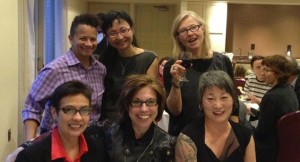Why Spanish women don’t write…
by Sue Burke, writer and certified translator living in Madrid, Spain
Why do women in Spain write very little speculative fiction (SF)? This umbrella term refers to science fiction, fantasy, alternate history, and horror, since they share overlapping authors and readers. It’s the genre I love and write in, and when I began to search for locally written SF when I moved to Spain thirteen years ago, I found lots of excellent work, but hardly any of it by women.
In the English-speaking world, things are different. Statistics from Broad Universe show that one-third of the SF authors are women and one-third of the published works are by female authors, although the data also reveal continuing problems and raise the question of why fewer women than men write SF in English. This is why Broad Universe, dedicated to promoting women writers in SF, is a busy organization.
(Mainstream writing suffers from similar problems, according to statistics in The Count by VIDA, which explores critical and cultural perceptions of writing by women.)
Equivalent statistics for SF in Spain haven’t been collected, but I have a piece of raw data at hand that in my experience is fairly representative. Among this year’s candidates for the Ignotus Awards, the top award for SF in Spain and equivalent to the Hugos, there are no women among the five nominations for novels, three out of five for novella, and only two out of seven for short story. Compared to the pool from which the nominees were drawn, women writers may actually be over-represented as candidates. Yet despite encouragement and recognition, Spanish women write hardly any SF.
The reason why takes us into a broader examination of Spanish culture. Laura Freixas, author of the book Literatura y mujeres (Literature and Women) and president of an organization for gender equality in culture, has provided some statistics about women in the arts:
On any given week, female authors account for 10% of the best-selling fiction by Spanish writers. Only 7% of films are directed by women. Only 5% of art exhibitions are of female artists. Only 24% of executives in the communications industry are women, though they are 46% of the professionals. In theater, among the candidates for the prestigious Max Prizes in 2008, 25% of the directors and 19% of the authors were women. Between 1977 and 1987, only 3% of the winners of the annual National Prize in the categories of fiction, non-fiction, and poetry were women; between 1998 and 2007, that number increased to a whopping 13%. In the leading magazine about literature and ideas, Letras Libres, only 8% of the correspondents are women.
“The absence of women among the creators of culture,” she concludes, “produce contents that legitimize and normalize the absence of women, and vice versa.”
Women may be absent in Spanish culture, but SF is an import, and it has its own rules even within Spain. Although the genre started in the United States, like another US invention, rock music, it grew across borders. And as it grew, SF developed certain trappings. These include a close connection to its fan base and rituals like annual conventions. This year, 6,060 people attended the 71st World Science Fiction Convention in San Antonio, Texas; next year, fans will gather in London. Spain celebrates a national annual convention similar to any other SF convention worldwide but unlike anything else in Spanish literature.
The worldwide SF community has always been connected by regular face-to-face meetings and by the best technology of its day. Decades ago, the letters columns of fanzines contained lively debates; now those debates have moved to the Internet. The worldwide web keeps the community connected with such sites as Europa SF, Science Fiction and Fantasy Translation Awards, countless others, through both personal blogs and organizational web pages. Fan and writers anywhere in the world can easily learn about authors like Isaac Asimov, Ursula K. Le Guin, Ken Liu, or Aliette de Bodard. And they can observe the continuing, noisy debate about gender equality in SF: for example this entry in Justine Larbalestier‘s blog. These debates become fodder for discussion in many languages.
What does that mean for the world’s female SF writers? Equality is the stated norm with an open, active, even acrimonious effort to achieve real equality. Another norm is the encouragement of new authors, so anyone who wants to write can get useful advice from the Science Fiction and Fantasy Writers of America. A good place for a thematic analysis is Ada, a journal of gender, new media, and technology; the genre has a deep past and present, and writers who understand it will write better.
But for female writers in Spain, the big hurdle to taking up the pen is located outside SF but within national borders. That seems harder to overcome, and the loss extends beyond the SF world.
For other writing by Sue Burke, visit: https://www.sue.burke.name








